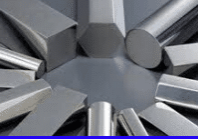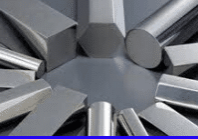Stainless Steel 316



316 Stainless Steel Suppliers
Stainless Steel 316: Available in round, flat, square, hexagonal, and tubular forms, 316L is a low carbon chromium-nickel-molybdenum austenitic stainless steel known for its excellent strength and superior corrosion resistance. It is supplied in the annealed condition with a typical Brinell hardness of around 175.
316 stainless steel is renowned for its high resistance to corrosion in both marine and industrial environments. It demonstrates exceptional resistance to chloride-induced corrosion and is highly resistant to sulphur compounds used in the pulp and paper industries. The addition of 2-3% molybdenum enhances its resistance to pitting corrosion and improves its performance at elevated temperatures, particularly in terms of creep resistance. The low carbon content minimizes the risk of intergranular corrosion (caused by carbide precipitation) during welding, often eliminating the need for post-weld annealing. The steel also offers good oxidation resistance at high temperatures.
Although 316L cannot be hardened through thermal treatment, its strength and hardness can be significantly improved by cold working, although this process reduces ductility.
An improved machinability version, achieved through calcium injection treatment, is also available. This process enhances machining speeds, increases feed rates, and extends tool life without significantly affecting corrosion resistance or weldability.
316 stainless steel is widely used across industries such as marine, chemical, pulp and paper, textile, transport, and manufacturing.
Common Applications of 316 Stainless Steel:
- Architectural components
- Textile machinery
- Pulp and paper processing equipment
- Marine equipment and fittings
- Photographic and X-ray equipment
| Related Specifications | |
| Australia | AS 2837-1986-316L |
| Germany | W.Nr 1.4404 X2CrNiMo17 13 2 W.Nr 1.4435 X2CrNiMo 18 14 3 |
| Great Britain | Bs970 Part 3 1991 316S11/316S13 |
| Japan | JIS G4303 SuS 316L |
| USA | ASTM A276-98b 316L SAE 30316L AISI 316L UNS S31603 |
Chemical Composition of 316
| Chemical Composition | ||
| Min. % | Max % | |
| Carbon | 0 | 0.03 |
| Silicon | 0 | 1.00 |
| Manganese | 0 | 2.00 |
| Nickel | 10.00 | 14.00 |
| Chromium | 16.00 | 18.00 |
| Molybdenum | 2.00 | 3.00 |
| Nitrogen | 0 | 0.10 |
| Phosphorous | 0 | 0.045 |
| Sulphur | 0 | 0.03 |
Mechanical Property and Heat treatments
| Mechanical Property Requirements - Annealed to ASTM A276-98b 316L | |||
| Finish | Hot Finish | Cold Finish | |
| Dia or Thickness mm | All | Up to 12.7 | Over 12.7 |
| Tensile Strength Mpa Min. | 485 | 620 | 485 |
| Yield Strength Mpa Min. | 170 | 310 | 170 |
| Elongation in 50mm % Min. | 40 | 30 | 30 |
| Typical Mechanical Properties At Room Temperature - Annealed | |||
| Finish | Cold Drawn | Other | |
| Tensile Strength Mpa | 680 | 590 | |
| Yield Strength Mpa | 500 | 280 | |
| Elongation in 50mm % | 42 | 55 | |
| Impact Charpy V J | 190 | 180 | |
| Hardness | HB | 195 | 155 |
| Rc | 13 |
| General Corrosion |
| 316L has better resistance to general corrosion in most media than 310, 304, 321, 302 and 303 grades. |
Stress Corrosion Cracking |
| 316L has a better resistance to stress corrosion cracking in chloride solutions than 302 or 304 grades, however it can also fail if subjected to high stresses in an environment conducive to stress corrosion. |
| Pitting Corrosion |
| 316L has a higher resistance to pitting corrosion than the non -molybdenum bearing grades such as 304, 321, 310 and 303 etc.. |
| Intergranular Corrosion |
| 316L due to its low carbon content has greater resistance to intergranular corrosion than all the austenitic stainless steel grades except 304L grade and 321 titanium |
| Crevice Corrosion |
| 316L has a higher resistance to crevice corrosion than the non-molybdenum bearing grades such as 304, 321, 310 and 303 etc.
It is most important that oxygen is always allowed to circulate freely on all stainless steel surfaces to ensure that a chrome oxide film is always present to protect it. If this is not the case, rusting will occur as with other types of non-stainless steel. For optimum corrosive resistance, surfaces must be free of scale and foreign particles. |
| Forging |
| Heat uniformly to 1150oC - 1200oC, and hold until temperature is uniform throughout the section.
Do not forge below 900oC Finished forgings should be air-cooled. Forgings will require to be annealed to obtain optimum corrosion resistance. |
Heat Treatment of 316 Stainless Steel |
| Annealing |
| Heat to 1020oC - 1100oC, hold until temperature is uniform throughout the section.
*Soak as required. Quench in water to obtain optimum corrosion resistance. Actual soaking time should be long enough to ensure that the part is heated thoroughly throughout its section to the required temperature, 30 minutes per 25 mm of the section may be used as a guide. Please consult your heat treater for the best results. |
Machining 316 Stainless Steel |
| 316L improved machinability is slightly more difficult to machine than improved machinability 304 grade. More difficult to machine than 303 free machining grade and most of the 400 series stainless steels. It has a typical machinability rating of around 50% - 55% of free machining (S1214) mild steel.
Due to the high work hardening rate of this grade, cutting or drilling tools etc. must be kept sharp at all times and not cause unnecessary work hardening of the surface etc.. All machining should be carried out as per machine manufacturers' recommendations for suitable tool types, feeds and speeds. |
Welding 316 Stainless Steel
| 316L is readily weldable by shielded fusion and resistance welding processes, followed by air cooling giving good toughness. Oxyacetylene welding is not recommended due to possible carbon pick-up in the weld area.
The low carbon content in 316L allows it to be welded without loss of corrosion resistance due to intergranular carbide precipitation, and post-weld annealing is not generally required, except for service in more extreme conditions. |
Welding Procedure |
| Welding should be carried out using 316L or *similar electrodes or rods (depending upon application). No pre-heat or post-heat is generally required.
*Please consult your welding consumables supplier. |
